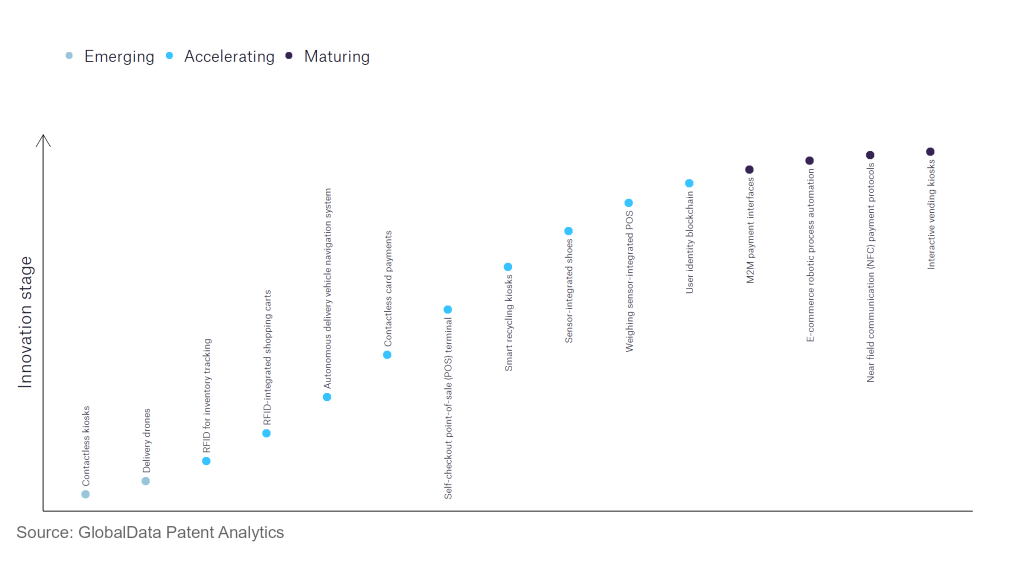The retail industry continues to be a hotbed of innovation, with activity driven by desire for convenience and technology, and growing importance of technologies such as the Internet of Things (IoT), telematics, contactless payments, and e-commerce robotic process automation. In the last three years alone, there have been over 133,000 patents filed and granted in the retail industry, according to GlobalData’s report on Internet of Things in Retail: Weighing sensor-integrated POS. Buy the report here.
However, not all innovations are equal and nor do they follow a constant upward trend. Instead, their evolution takes the form of an S-shaped curve that reflects their typical lifecycle from early emergence to accelerating adoption, before finally stabilising and reaching maturity.
Identifying where a particular innovation is on this journey, especially those that are in the emerging and accelerating stages, is essential for understanding their current level of adoption and the likely future trajectory and impact they will have.
70+ innovations will shape the retail industry
According to GlobalData’s Technology Foresights, which plots the S-curve for the retail industry using innovation intensity models built on over 128,000 patents, there are 70+ innovation areas that will shape the future of the industry.
Within the emerging innovation stage, contactless kiosks and delivery drones are disruptive technologies that are in the early stages of application and should be tracked closely. RFID for inventory tracking, autonomous delivery vehicle navigation system, and contactless card payments are some of the accelerating innovation areas, where adoption has been steadily increasing. Among maturing innovation areas are M2M payment interfaces and e-commerce robotic process automation, which are now well established in the industry.
Innovation S-curve for Internet of Things in the retail industry

Weighing sensor integrated POS is a key innovation area in Internet of Things
Weight sensors are devices that are used to measure load and force. They give the form of an electric signal to the weight to be measured. This electric signal can be used in various applications. IoT weight sensors are weighing scales connected to the cloud. These sensors can measure weights, which can be uploaded periodically to a remote server. Weight sensors find significant applications at point of sale (POS), as they enable retailers to get accuracy and consistency in measuring the products that are sold.
GlobalData’s analysis also uncovers the companies at the forefront of each innovation area and assesses the potential reach and impact of their patenting activity across different applications and geographies. According to GlobalData, there are 10+ companies, spanning technology vendors, established retail companies, and up-and-coming start-ups engaged in the development and application of weighing sensor integrated POS.
Key players in weighing sensor integrated POS – a disruptive innovation in the retail industry
‘Application diversity’ measures the number of different applications identified for each relevant patent and broadly splits companies into either ‘niche’ or ‘diversified’ innovators.
‘Geographic reach’ refers to the number of different countries each relevant patent is registered in and reflects the breadth of geographic application intended, ranging from ‘global’ to ‘local’.
Patent volumes related to weighing sensor integrated POS
| Company | Total patents (2021 - 2023) | Premium intelligence on the world's largest companies |
| Toshiba | 88 | Unlock Company Profile |
| Angel Playing Cards | 62 | Unlock Company Profile |
| Accel Robotics | 17 | Unlock Company Profile |
| Illinois Tool Works | 17 | Unlock Company Profile |
| Walmart | 16 | Unlock Company Profile |
| NCR | 15 | Unlock Company Profile |
| Metrologic Instruments | 13 | Unlock Company Profile |
| Extreme Networks | 9 | Unlock Company Profile |
| Seven & i Holdings | 8 | Unlock Company Profile |
| TERAOKA SEIKO | 8 | Unlock Company Profile |
| Mettler-Toledo International | 6 | Unlock Company Profile |
| SuperSmart | 6 | Unlock Company Profile |
| Midea Holding | 5 | Unlock Company Profile |
| eBay | 5 | Unlock Company Profile |
Source: GlobalData Patent Analytics
Leading players in the weighing sensor integrated POS space in terms of patents filed are Toshiba, Angel Playing Cards, Accel Robotics, Illinois Tool Works, and Walmart. Toshiba offers a self-scanning solution called SuperSmart Scan & Go, which enables protection against fraud and shopper convenience. Offered by Bizerba, Toshiba’s partner, the solution provides mobile scanning through a store-owned device or a smartphone. Validation happens within a short period at checkout, using weight sensors, visual recognition, shopping patterns, and artificial intelligence (AI).
Leading players in the weighing sensor integrated POS space in terms of application diversity are Angel Playing Cards, Accel Robotics, Seven & i, and Extreme Networks.
Midea, Walmart, Angel Playing Cards, and Illinois Tool Works lead the space in terms of geographic reach.
IoT-enabled weight sensors help retailers in remotely monitoring the movement of products that are measured in terms of weight, such as groceries. As a result, IoT-enabled weighing sensor integrated POS will be adopted by more retailers in the future.
To further understand the key themes and technologies disrupting the retail industry, access GlobalData’s latest thematic research report on Internet of Things (IoT) in Retail and Apparel.
Data Insights
From

The gold standard of business intelligence.
Blending expert knowledge with cutting-edge technology, GlobalData’s unrivalled proprietary data will enable you to decode what’s happening in your market. You can make better informed decisions and gain a future-proof advantage over your competitors.



